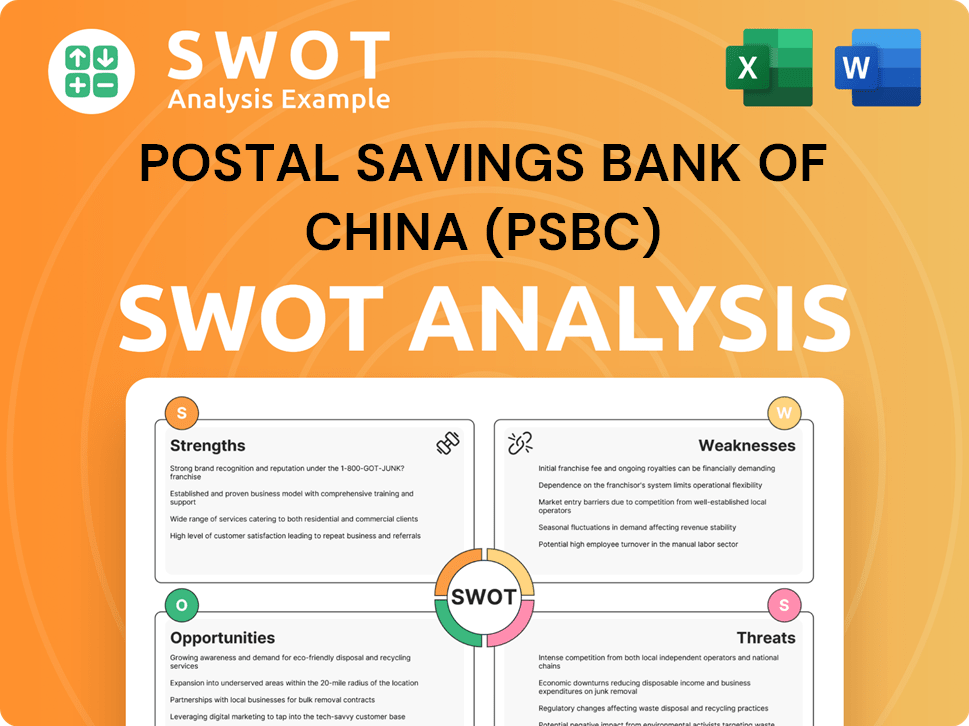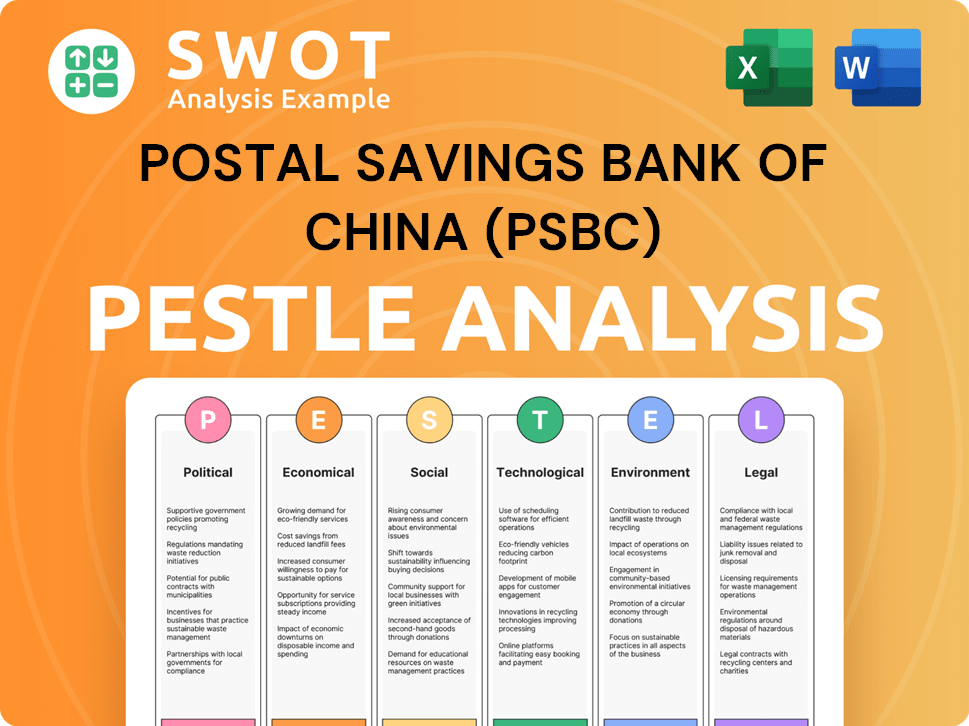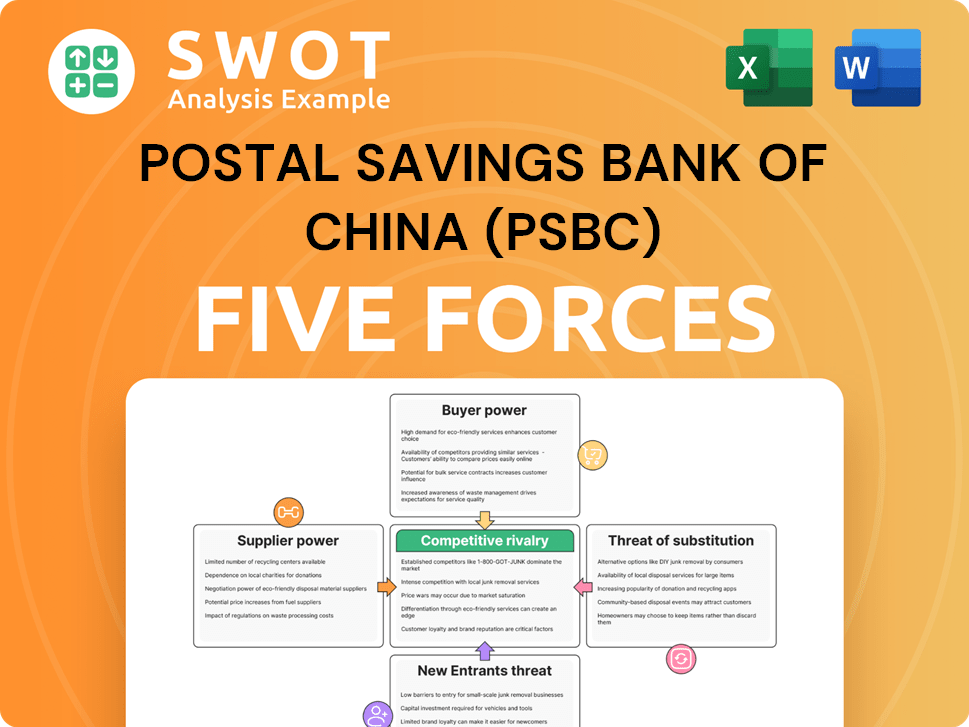Postal Savings Bank Of China (PSBC) Bundle
How Does Postal Savings Bank of China (PSBC) Thrive in China's Banking Arena?
Explore the dynamic Postal Savings Bank Of China (PSBC) SWOT Analysis to understand its unique position within China's vast financial sector. Founded in 2007, PSBC leveraged an unmatched distribution network, particularly in rural areas, setting it apart from traditional commercial banks. With nearly 40,000 outlets and over 670 million customers by the end of 2024, PSBC's reach is undeniable.

This deep dive into the competitive landscape of PSBC will analyze its key differentiators and rivals. We will examine its market share analysis and financial performance comparison within the banking industry in China. Understanding PSBC's business strategy, customer base, and digital banking initiatives is crucial for investors and strategists alike. This analysis will also touch on PSBC's future growth prospects and investment opportunities, considering the regulatory environment and risk assessment.
Where Does Postal Savings Bank Of China (PSBC)’ Stand in the Current Market?
Postal Savings Bank of China (PSBC) holds a prominent position within China's banking industry, distinguished by its extensive retail network and focus on inclusive finance. By the end of 2024, PSBC had approximately a 5% market share in China by deposit balance. This ranking placed it as the fifth-largest commercial bank in terms of deposits and sixth by assets.
PSBC's core operations revolve around providing a wide array of financial services, including deposit and loan products, wealth management, and investment banking. Its vast network of nearly 40,000 outlets, covering all urban cities and 99% of counties, enables it to serve a massive customer base. This strong presence, especially in rural areas, is a key differentiator in the Growth Strategy of Postal Savings Bank Of China (PSBC).
The bank's value proposition lies in its ability to provide accessible and inclusive financial services across a broad geographic area, catering to both individual and corporate clients. By the end of 2024, PSBC served over 670 million personal customers.
PSBC ranked fifth-largest commercial bank by deposits and sixth by assets in China as of the end of 2024. Its market share by deposit balance was approximately 5%.
By the end of fiscal year 2024, PSBC's total assets reached RMB 17.1 trillion, with total deposits at RMB 15.3 trillion and total loans amounting to RMB 8.7 trillion.
PSBC offers deposit and loan products, wealth management, and investment banking services. The bank caters to both individual and corporate customers.
PSBC has nearly 40,000 outlets across China, covering all urban cities and 99% of counties. It serves over 670 million personal customers by the end of 2024.
PSBC has strategically focused on 'Sannong Business', micro and small enterprises (MSEs), wealth management, and financial market businesses. By the end of 2024, Sannong-related loans constituted over 25% of its total loan book.
- The balance of inclusive loans to MSEs reached RMB 1.63 trillion by the end of 2024.
- PSBC reported a net profit of RMB 86.424 billion in 2023.
- As of the end of 2024, PSBC's core Tier 1 ratio was 9.56%, Tier 1 ratio 11.89%, and capital adequacy ratio 14.44%.
- The bank's equity-to-total-asset ratio stood at 6% as of 2024.
Postal Savings Bank Of China (PSBC) SWOT Analysis
- Complete SWOT Breakdown
- Fully Customizable
- Editable in Excel & Word
- Professional Formatting
- Investor-Ready Format

Who Are the Main Competitors Challenging Postal Savings Bank Of China (PSBC)?
The Postal Savings Bank of China (PSBC) operates within a highly competitive banking sector in China. Its competitive landscape is shaped by a mix of large state-owned banks, national joint-stock banks, and a fragmented group of smaller financial institutions. Understanding the key players and their strategies is crucial for assessing PSBC's position and future prospects. This Owners & Shareholders of Postal Savings Bank Of China (PSBC) article provides insights into the competitive environment.
The banking industry in China is dynamic, with constant shifts in market share and strategic initiatives. The competitive pressure is intensified by factors such as falling interest rates and government policies. These factors affect the profitability and operational strategies of all banks, including PSBC, necessitating continuous adaptation and innovation to maintain a competitive edge.
PSBC's most significant direct competitors are the 'Big Four' state-owned commercial banks: Industrial and Commercial Bank of China (ICBC), Agricultural Bank of China (ABC), China Construction Bank (CCB), and Bank of China (BOC).
ICBC is the largest bank globally by assets, holding over $6.3 trillion as of April 2024. These banks compete with PSBC across all segments, particularly in corporate banking and wealth management.
In Q1 2025, the 'Big Four' experienced a net profit decrease of 1.90% year-on-year, though ABC and Bank of Communications (BOCOM) reported increases. These large banks have vast resources and established brand recognition.
Other significant competitors include national joint-stock commercial banks such as Bank of Communications (BOCOM) and China Merchants Bank. These banks often focus on more urbanized and commercially active regions.
They provide a broader range of financial products and services, including more sophisticated investment banking and digital solutions. In Q1 2025, national joint-stock banks saw their net profit decrease by 1.98% year-on-year.
Indirect competition comes from city commercial banks and rural commercial banks and credit cooperatives. PSBC holds a dominant position in the rural banking market, but these smaller institutions tailor products to local needs.
The competitive landscape for PSBC is further shaped by the emergence of fintech companies and digital payment platforms. These entities disrupt traditional banking services, offering convenient and often lower-cost alternatives, particularly in payments, lending, and wealth management.
- Fintech Disruption: Fintech companies leverage technology to offer innovative financial services.
- Digital Payment Platforms: Digital payment platforms are gaining popularity, challenging traditional banking methods.
- Rural Banking Consolidation: The rural banking sector is undergoing consolidation, leading to larger regional competitors. Over 260 small and medium-sized rural financial institutions underwent mergers and acquisitions as of late September 2024.
- Market Dynamics: Falling interest rates and government calls to reduce financing costs intensify competition.
Postal Savings Bank Of China (PSBC) PESTLE Analysis
- Covers All 6 PESTLE Categories
- No Research Needed – Save Hours of Work
- Built by Experts, Trusted by Consultants
- Instant Download, Ready to Use
- 100% Editable, Fully Customizable

What Gives Postal Savings Bank Of China (PSBC) a Competitive Edge Over Its Rivals?
The competitive landscape for Postal Savings Bank of China (PSBC) is shaped by its unique strengths, particularly its extensive distribution network and focus on inclusive finance. PSBC's strategy involves leveraging its vast physical presence to reach underserved markets and expanding its digital capabilities to enhance customer service and operational efficiency. This approach allows PSBC to differentiate itself within the dynamic Chinese banking industry.
Key milestones include the bank's initial public offering and its ongoing efforts to improve its digital infrastructure. Strategic moves involve the expansion of its lending programs for micro and small enterprises (MSEs) and the enhancement of its technology finance initiatives. These efforts are part of PSBC's broader strategy to maintain a competitive edge in a rapidly evolving market.
PSBC's competitive edge is built on its widespread physical presence, a strong deposit base, and a strategic focus on inclusive finance. These advantages enable PSBC to effectively serve a large and diverse customer base, particularly in rural areas, and support its long-term growth objectives. For a deeper understanding of the bank's origins, you can read the Brief History of Postal Savings Bank Of China (PSBC).
PSBC's vast network of nearly 40,000 outlets, including over 8,000 directly owned, provides unparalleled reach across China. This extensive presence, covering all urban areas and approximately 99% of counties, enables PSBC to effectively serve a large and diverse customer base. This broad reach is a significant advantage in a market as geographically varied as China.
PSBC benefits from a strong deposit franchise, supported by its long-term operations in postal savings and remittance outlets. As of FY24, total deposits reached RMB 15.3 trillion. This stable funding base provides a cost advantage and supports the bank's lending activities, contributing to its financial stability and growth.
PSBC strategically focuses on inclusive finance, particularly its 'Sannong Business' (agriculture, countryside, farmers) and MSE lending. By the end of 2024, Sannong-related loans made up more than 25% of its total loan book. This focus allows PSBC to tap into segments with strong growth potential often underserved by larger commercial banks.
PSBC has demonstrated prudent underwriting standards and maintains a relatively cleaner corporate loan book compared to other state-owned enterprise (SOE) banks. Its non-performing loan (NPL) ratio was 0.83% in 2023, and its allowance to NPLs ratio was 347.57%, indicating strong asset quality and risk control. This approach contributes to the bank's financial stability.
PSBC's competitive advantages are multifaceted, encompassing its extensive branch network, strong deposit base, and strategic focus on inclusive finance. These factors collectively position PSBC favorably within the competitive landscape of the Chinese banking industry, allowing it to effectively serve a broad customer base and achieve sustainable growth.
- Unparalleled Distribution Network: Nearly 40,000 outlets provide extensive reach.
- Strong Deposit Base: Total deposits reached RMB 15.3 trillion as of FY24.
- Focus on Inclusive Finance: Sannong-related loans accounted for over 25% of the loan book by the end of 2024.
- Prudent Risk Management: NPL ratio of 0.83% in 2023 and a high allowance to NPLs ratio.
Postal Savings Bank Of China (PSBC) Business Model Canvas
- Complete 9-Block Business Model Canvas
- Effortlessly Communicate Your Business Strategy
- Investor-Ready BMC Format
- 100% Editable and Customizable
- Clear and Structured Layout

What Industry Trends Are Reshaping Postal Savings Bank Of China (PSBC)’s Competitive Landscape?
The banking industry in China, including Postal Savings Bank of China (PSBC), is currently navigating a dynamic environment. This environment is characterized by shifting trends, significant challenges, and emerging opportunities. PSBC faces a complex interplay of economic factors, regulatory changes, and competitive pressures that will shape its performance in 2024 and beyond. Understanding this landscape is crucial for assessing the bank's strategic positioning and future prospects.
PSBC's competitive landscape is influenced by both macroeconomic conditions and specific industry dynamics. The bank's ability to adapt to these changes will be critical for maintaining its market position and achieving sustainable growth. The following sections will delve into the key industry trends, challenges, and opportunities that PSBC is likely to encounter, providing a detailed market analysis.
A key trend is the narrowing net interest margin (NIM) across China's banking sector. The average NIM for commercial banks fell to 1.52% by the end of 2024. Loan growth is projected to slow, affecting the six largest banks. This situation is driven by falling interest rates and government calls to reduce financing costs.
Prolonged real estate slump and weak domestic demand present significant challenges. Retail loan quality faces rising risks due to the worsening credit cycle. Geopolitical tensions and rising tariff risks further complicate the economic outlook. The consolidation of small and medium-sized rural financial institutions creates increased competition.
China's government is implementing pro-economic growth policies. PSBC is strategically aligning with national priorities focusing on technology finance, green finance, and digital finance. The wealth management business is expected to grow in 2025. PSBC's extensive network in rural areas provides opportunities.
PSBC is focusing on 'five priorities': technology finance, green finance, inclusive finance, pension finance, and digital finance. The bank's engagement in technology finance is growing, with nearly 100,000 technology enterprises served. Green loans reached RMB 781.732 billion by the end of 2024, an increase of 22.55%.
The banking industry in China is undergoing significant changes, impacting institutions like PSBC. The bank's strategies and performance are significantly shaped by macroeconomic conditions, government policies, and competitive pressures. The ability to adapt is key for PSBC's success.
- Market Analysis PSBC: The competitive landscape includes both state-owned and private banks.
- PSBC business strategy: Focus on key areas like technology and green finance.
- PSBC future growth prospects: Leveraging its extensive network and strategic alignment.
- PSBC risk assessment: Addressing challenges related to asset quality and economic conditions. For more insights, read about the Growth Strategy of Postal Savings Bank Of China (PSBC).
Postal Savings Bank Of China (PSBC) Porter's Five Forces Analysis
- Covers All 5 Competitive Forces in Detail
- Structured for Consultants, Students, and Founders
- 100% Editable in Microsoft Word & Excel
- Instant Digital Download – Use Immediately
- Compatible with Mac & PC – Fully Unlocked

Related Blogs
- What are Mission Vision & Core Values of Postal Savings Bank Of China (PSBC) Company?
- What is Growth Strategy and Future Prospects of Postal Savings Bank Of China (PSBC) Company?
- How Does Postal Savings Bank Of China (PSBC) Company Work?
- What is Sales and Marketing Strategy of Postal Savings Bank Of China (PSBC) Company?
- What is Brief History of Postal Savings Bank Of China (PSBC) Company?
- Who Owns Postal Savings Bank Of China (PSBC) Company?
- What is Customer Demographics and Target Market of Postal Savings Bank Of China (PSBC) Company?
Disclaimer
All information, articles, and product details provided on this website are for general informational and educational purposes only. We do not claim any ownership over, nor do we intend to infringe upon, any trademarks, copyrights, logos, brand names, or other intellectual property mentioned or depicted on this site. Such intellectual property remains the property of its respective owners, and any references here are made solely for identification or informational purposes, without implying any affiliation, endorsement, or partnership.
We make no representations or warranties, express or implied, regarding the accuracy, completeness, or suitability of any content or products presented. Nothing on this website should be construed as legal, tax, investment, financial, medical, or other professional advice. In addition, no part of this site—including articles or product references—constitutes a solicitation, recommendation, endorsement, advertisement, or offer to buy or sell any securities, franchises, or other financial instruments, particularly in jurisdictions where such activity would be unlawful.
All content is of a general nature and may not address the specific circumstances of any individual or entity. It is not a substitute for professional advice or services. Any actions you take based on the information provided here are strictly at your own risk. You accept full responsibility for any decisions or outcomes arising from your use of this website and agree to release us from any liability in connection with your use of, or reliance upon, the content or products found herein.